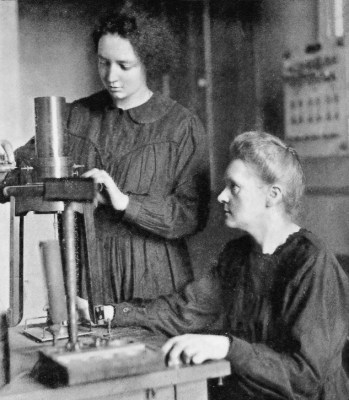When Marie and Pierre Curie discovered the natural radioactive elements polonium and radium, they did something truly remarkable– they uncovered an entirely new property of matter. The Curies’ work was the key to unlocking the mysteries of the atom, which was previously thought to be indivisible. Their research opened the door to nuclear medicine and clean energy, and it also led to the development of nuclear weapons.
Irène Joliot-Curie, her husband Frédéric, and many of their contemporaries were completely against the use of nuclear science as a weapon. They risked their lives to guard their work from governments hell-bent on destruction, and most of them, Irène included, ultimately sacrificed their health and longevity for the good of society.
Childhood
Irène Curie was born September 12th, 1897 in Paris to Marie and Pierre Curie. She was a shy, serious child and quite attached to her mother. Irène idolized Marie from the start and spent her life trying to get closer to her. But the Curies spent long hours working in the lab. Once they won the Nobel Prize for discovering radium, Irene saw her mother even less.
Marie Curie was wary of the French educational system, which discouraged free thought in favor of rote memorization. So she and a few other parents formed a collective educational commune and took turns teaching each other’s children a diverse array of subjects from Chinese to sculpture. After a few years, the collective disbanded and Irène enrolled in a private school in Paris.
When Irène was eight years old, her father was trampled by the horses of a stagecoach and died instantly. Marie was so consumed by grief that she would avoid or abruptly end any conversation about Pierre, which frustrated Irène and further alienated her from her mother. Whenever they weren’t in school, Marie sent Irène and her younger sister Eve to stay with their aunt in a cottage by the sea while she worked in the lab and picked up the pieces of her life.
Futuristic Florence Nightingale
World War I erupted when Irène was seventeen. After a few months, she was finally reunited with her mother.
Marie threw herself into the war effort. She built a fleet of 20 mobile x-ray labs using donated vehicles, and powered the equipment with dynamos that ran off the cars’ engines. Irène took a nursing course and helped Marie teach doctors and nurses how to take x-rays of wounded soldiers. Many were skeptical of the technology until they saw for themselves how useful it could be to spot bone fractures and facilitate easy removal of bullets and shrapnel.
Irène traveled with her mother for two years before going back to school. She wasted no time, earning three degrees with distinction in just two years at the Faculty of Science in Sarbonne. Whenever she had time, she’d go back to the battlefield to help x-ray soldiers. Over the …read more
Source:: Hackaday

